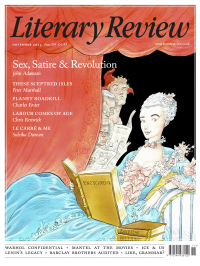Dorian Lynskey
Bicycle Sharers of the World Unite!
Beauty is in the Street: Protest and Counterculture in Post-War Europe
By Joachim C Häberlen
Allen Lane 512pp £35
In April 1967, the radical denizens of Kommune I in West Berlin hatched a plan to assail the visiting US vice president, Hubert Humphrey, with ‘pudding bombs’ made of flour and custard. ‘Laughter must be on our side,’ they declared. They were arrested before they could unleash the desserts. The following month, after a horrific department store fire in Brussels, they issued a pamphlet which asked, ‘When will Berlin’s department stores burn?’ Two communards, Fritz Teufel and Rainer Langhans, were arrested again, this time for advocating arson, and turned their trial into a satirical media spectacle. After the acquittal of the ‘fun guerrillas’, Kommune I enjoyed a period of countercultural celebrity – Jimi Hendrix dropped by one day – but by the end of 1969 it had disintegrated. Langhans went on to create a women’s commune (known, to his annoyance, as ‘the Harem’); Teufel joined the militant 2 June Movement and was jailed twice for complicity in firebombing and kidnapping.
The story of Kommune I has familiar contours: the rebel whimsy, the rejection of societal norms, the mixture of hedonism and violence. The communards’ courtroom performance feels like a dress rehearsal for the Yippies’ antics at the trial of the Chicago Seven two years later, while Langhans and his model girlfriend, Uschi Obermaier, were promoting the sexual revolution before John Lennon and Yoko Ono. America’s postwar counterculture – Huey Newton and Abbie Hoffman, Gloria Steinem and Bernardine Dohrn, ‘Blowin’ in the Wind’ and the Port Huron Statement, ‘Don’t trust anyone over thirty’ and ‘The whole world is watching’ – has been mythologised in songs, movies and bestselling books. Although Europe had the uprisings in Paris and Prague in 1968, the revolutionary violence of the 1970s and theorists such as Herbert Marcuse and Guy Debord, the counterculture it produced tends to take second place in the Anglophone world’s imagination. Joachim C Häberlen’s wide-ranging book gives the continent its due.
Häberlen, a German historian who until recently taught at the University of Warwick, is not primarily interested in street-fighting men. He is drawn instead to blue-sky attempts to design a better world in microcosm, between the Scylla of Soviet communism and the Charybdis of capitalism. He takes us

Sign Up to our newsletter
Receive free articles, highlights from the archive, news, details of prizes, and much more.@Lit_Review
Follow Literary Review on Twitter
Twitter Feed
Alfred, Lord Tennyson is practically a byword for old-fashioned Victorian grandeur, rarely pictured without a cravat and a serious beard.
Seamus Perry tries to picture him as a younger man.
Seamus Perry - Before the Beard
Seamus Perry: Before the Beard - The Boundless Deep: Young Tennyson, Science, and the Crisis of Belief by Richard Holmes
literaryreview.co.uk
Novelist Muriel Spark had a tongue that could produce both sugar and poison. It’s no surprise, then, that her letters make for a brilliant read.
@claire_harman considers some of the most entertaining.
Claire Harman - Fighting Words
Claire Harman: Fighting Words - The Letters of Muriel Spark, Volume 1: 1944-1963 by Dan Gunn
literaryreview.co.uk
Of all the articles I’ve published in recent years, this is *by far* my favourite.
✍️ On childhood, memory, and the sea - for @Lit_Review :
https://literaryreview.co.uk/flotsam-and-jetsam